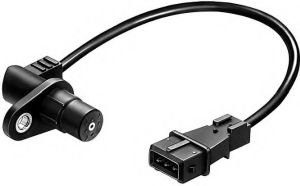
How to check a PMH sensor?
Content
Sensor Top dead center (TDC) of your vehicle determines the position pistons... It then transmits this information to the engine ECU, which can then determine the fuel injection required for speed. If the TDC sensor is defective, you will have startup problems... Here's how to check a PMH sensor.
Material:
- Penetrating
- Chiffon
- Tools
- Voltmeter
- oscilloscope
- Multimeter
🔎 Step 1: Visually check the TDC sensor.

To test the TDC sensor, you must first access it. The TDC sensor, also called the crankshaft sensor, is located on the crankshaft and flywheel at the bottom of the engine. Remove the sensor retaining screw and disconnect the harness between the TDC sensor and the engine ECU.
Let's start with a simple visual check of the TDC sensor:
- Make sure it is not clogged;
- Make sure the air gap is not damaged;
- Check harness between TDC sensor and engine ECU.
You can also take the opportunity to check your PMH sensor using a compass. It's kind of a little preliminary test, it can tell you if the sensor is working. Indeed, an inductive TDC sensor has a magnetic field that detects metal objects.
- If the sensor is pulling north, it works;
- If he draws south, he is HS!
Warning, this test does not work with an active PHM sensor, also known as a Hall effect. The active TDC sensor does not have an electromagnetic field because it is completely electronic. It is found, in particular, on the most recent engines.
💧 Step 2. Clean the TDC sensor.

For full functionality, the TDC sensor must not be contaminated. Here's how to clean the TDC sensor before checking it:
- Spray WD 40 or any other grease on the sensor body;
- Wipe gently with a clean cloth until all dirt and rust is removed.
⚡ Step 3. Check the electrical signal and the resistance of the TDC sensor.

Then you check the electrical signal and resistance of your TDC sensor. However, be careful with the type of sensor in question: if you have an active TDC sensor, you have no resistance to test. You can only check the signal from the Hall effect TDC sensor.
Use an ohmmeter or multimeter to check the inductive TDC sensor. Connect a multimeter to the output of the TDC sensor and check the displayed value. It depends on the vehicle manufacturer. In any case, it will be between 250 and 1000 ohms. If it is zero, there is a short circuit somewhere.
Then check the electrical signal. Use an oscilloscope to test a Hall effect TDC sensor that has 3 wires (positive, negative and signal). It turned out to be rectangular. For an active TDC sensor, the oscilloscope is sinusoidal.
Check the output signal with a voltmeter. Disconnect the TDC sensor connector and connect a voltmeter to the AC outlet. The result of a good TDC sensor is between 250 mV and 1 Volt.
👨🔧 Step 4. Run electronic diagnostics.

However, the most reliable and reliable way to check the TDC sensor, electronic diagnostics, is not available to everyone. Indeed, then you should have a diagnostic case and the accompanying autodiagnostic software. However, this tool is very expensive and usually only owned by professional mechanics. But if you are a mechanic, there is nothing stopping you from investing.
The diagnostic software returns an error code that indicates the nature of the problem with the TDC sensor (for example, no signal). You can also run diagnostics at startup to observe, with a maintained curve, correct operation of the sensor.
🔧 Step 5: Assemble the TDC sensor

After checking the TDC sensor, you must reassemble it. Install the sensor flat, tighten the fixing screw. Reconnect the sensor harness, then start the vehicle to make sure it is working properly.
That's it, you know how to test a PMH sensor! But, as you already understood, the best test is still electronic diagnostics, the codes of which allow you to find out exactly what the problem is. To check and replace PMH sensorso compare the garages around and entrust your car to the pros!